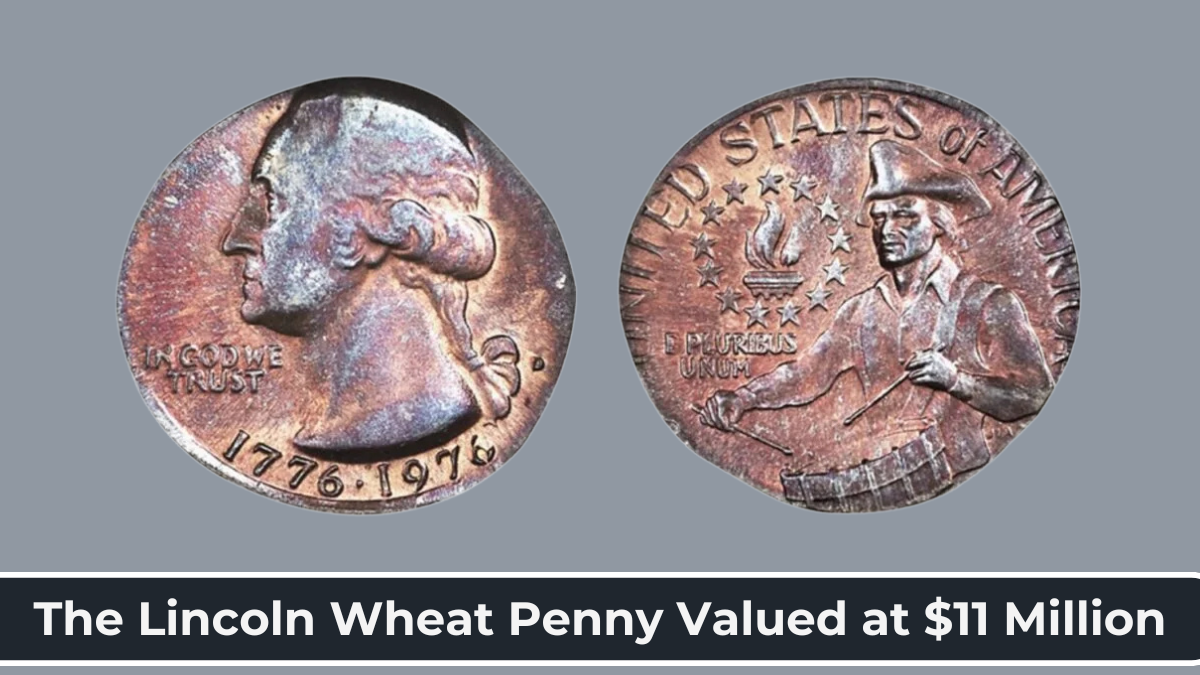Imagine discovering millions of dollars in your pocket change. While it sounds like a dream, this could become reality for someone holding a rare 1943 Copper Lincoln Wheat Penny. With an estimated value of $11 million, this extraordinary coin is still believed to be somewhere in circulation. The story of this numismatic treasure is a fascinating mix of historical significance, a wartime minting error, and the possibility that you could be the one to find it.
The Birth of the Lincoln Wheat Penny
The Lincoln Wheat Penny was first minted in 1909 to commemorate the 100th anniversary of Abraham Lincoln’s birth. It was a landmark moment in U.S. coinage, as it was the first American coin to feature a real historical figure instead of Lady Liberty or Native American imagery.
The design by Victor D. Brenner included:
- Obverse (Front): A dignified portrait of Abraham Lincoln, honoring his legacy.
- Reverse (Back): Two wheat stalks framing “ONE CENT” and “UNITED STATES OF AMERICA”, symbolizing America’s agricultural prosperity.
This design remained in use until 1958, when it was replaced by the Lincoln Memorial Penny.
The 1943 Copper Penny: A Wartime Mistake
During World War II, copper was a critical war material used for ammunition and military supplies. As a result, the U.S. Mint stopped using copper for pennies and switched to zinc-coated steel. These steel pennies had a distinctive silvery color and were the only official pennies produced that year.
However, a minting error led to a few 1943 pennies being struck on leftover copper planchets from 1942. This mistake created one of the rarest and most valuable coins in American history.
Why Is the 1943 Copper Penny Worth $11 Million?
The staggering value of this coin comes from several factors:
Extremely Rare – Only 12 to 20 genuine 1943 Copper Pennies are known to exist.
Historical Significance – Minted during WWII, it’s a symbol of wartime resource conservation.
Minting Error – It was never supposed to exist, making it a numismatic anomaly.
Collector Demand – With such limited supply, high-profile collectors are willing to pay millions for it.
One Missing Example – One Philadelphia-minted 1943 Copper Penny is rumored to still be in circulation, adding to the intrigue.
How to Identify a 1943 Copper Penny
Because of its high value, fake 1943 Copper Pennies are common. Many forgeries are copper-plated steel pennies or altered 1948 coins.
Here’s how to check if you have a real 1943 Copper Penny:
Magnet Test – A genuine 1943 Copper Penny will NOT stick to a magnet. Steel pennies will.
Weight Test – A copper penny weighs 3.11 grams, while a steel penny weighs 2.7 grams.
Date Inspection – The numbers should be evenly spaced and unaltered.
Mint Mark – The rarest version has no mint mark, meaning it was minted in Philadelphia.
Professional Authentication – PCGS (Professional Coin Grading Service) or NGC (Numismatic Guaranty Company) can verify its authenticity.
The Great American Coin Hunt
The most exciting part of this story? One of these rare pennies is believed to still be out there!
Unlike other rare coins that are safely stored in collections or museums, one missing 1943 Copper Penny could still be in circulation. It could be:
Hidden in an old jar of pennies
Sitting in a forgotten collection
Passed through everyday transactions unknowingly
This possibility keeps collectors, treasure hunters, and even everyday people searching for it—adding excitement to the world of numismatics.
Other Valuable Lincoln Wheat Pennies
While the 1943 Copper Penny is the most famous, several other Lincoln Wheat Pennies also hold impressive values:
| Coin | Estimated Value | Notable Feature |
|---|---|---|
| 1909-S VDB | Up to $100,000 | First Lincoln cent with designer’s initials. |
| 1914-D | Up to $150,000 | Rare Denver Mint production. |
| 1922 “No D” | Up to $90,000 | Denver Mint error—missing mint mark. |
| 1943 Copper Penny | Up to $1.7 million | Mistakenly struck in copper instead of steel. |
| 1955 Doubled Die | Up to $125,000 | Double-struck design creates a unique effect. |
How to Preserve and Sell a Valuable Penny
If you think you’ve found a rare Lincoln Wheat Penny, follow these steps:
- DO NOT clean the coin – Cleaning damages the surface and lowers its value.
- Handle with care – Always hold by the edges to prevent fingerprints and contamination.
- Store in a protective case – Use a certified coin holder to prevent damage.
- Get it professionally graded – Authentication by PCGS or NGC ensures maximum value.
- Sell through reputable dealers – Auction houses like Heritage Auctions or coin marketplaces provide secure and high-value transactions.
The Legacy of the Lincoln Wheat Penny
Beyond its monetary worth, the 1943 Copper Lincoln Wheat Penny is a historical artifact. It tells a story of wartime resource conservation, minting errors, and the evolution of American coinage.
For collectors, the thrill of finding a rare coin in an unexpected place keeps the hobby exciting. Whether in old collections, flea markets, or even pocket change, the possibility of uncovering a hidden fortune is always there.
So, before you dismiss your spare change, take a moment to check your pennies—you might be holding an $11 million treasure in your hands!
FAQs
Only about 12 to 20 genuine 1943 Copper Pennies are known today.
A real 1943 Copper Penny does NOT stick to a magnet and weighs 3.11 grams.
Sell through auction houses, coin dealers, or numismatic marketplaces like Heritage Auctions.
A 1943 Copper Penny sold for $1.7 million, but some estimate the missing one could be worth $11 million.
Yes! A missing 1943 Copper Penny could still be in circulation today.

